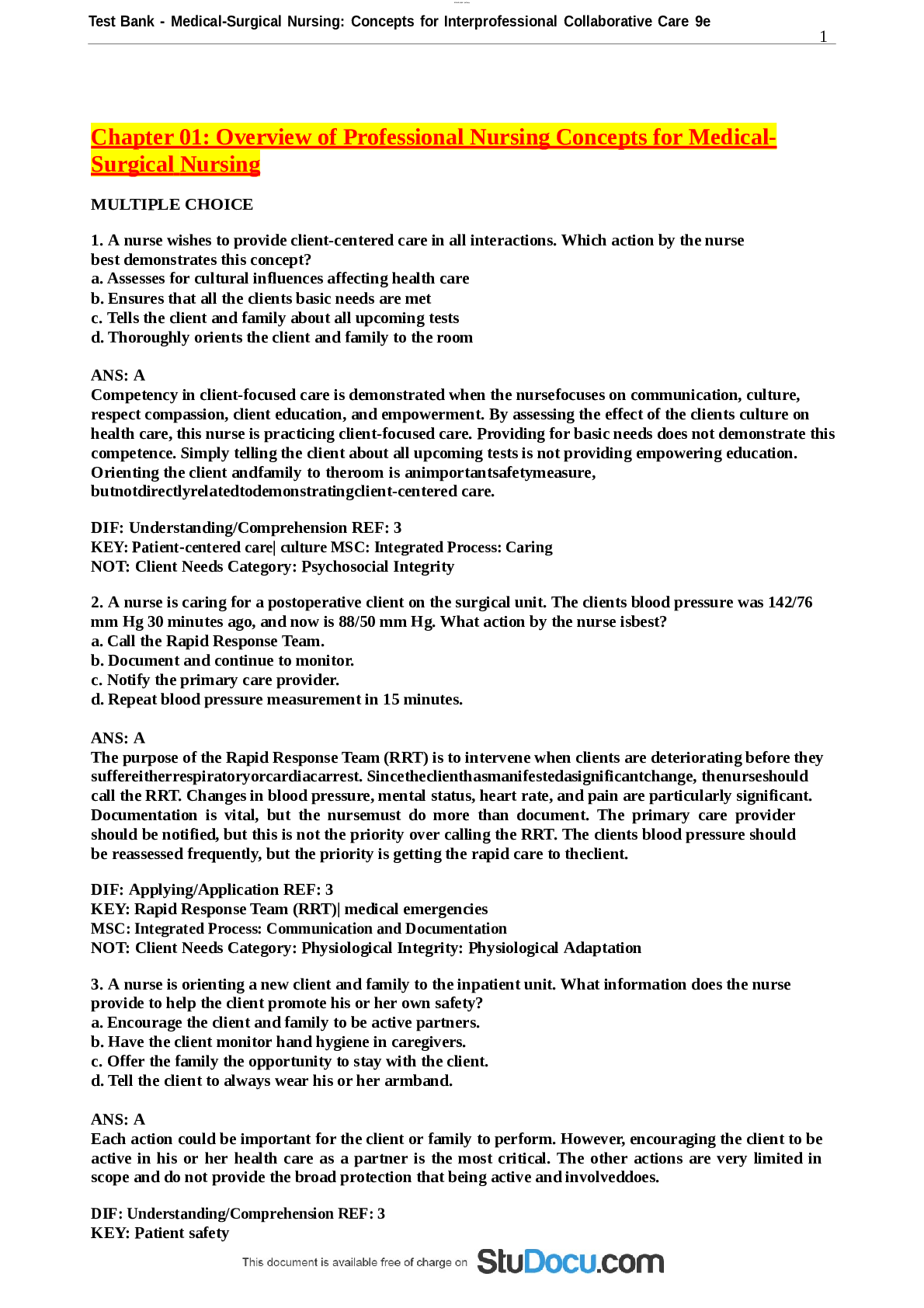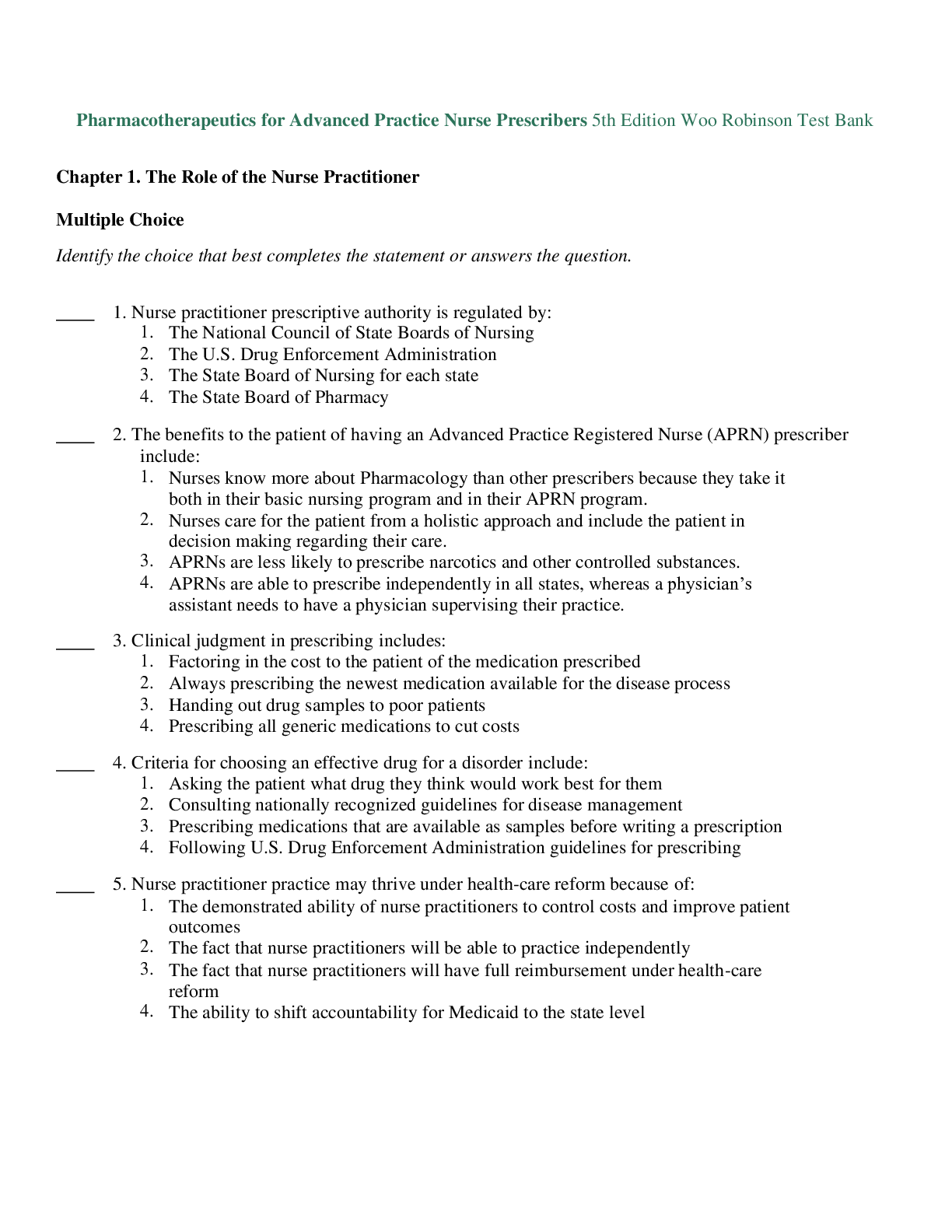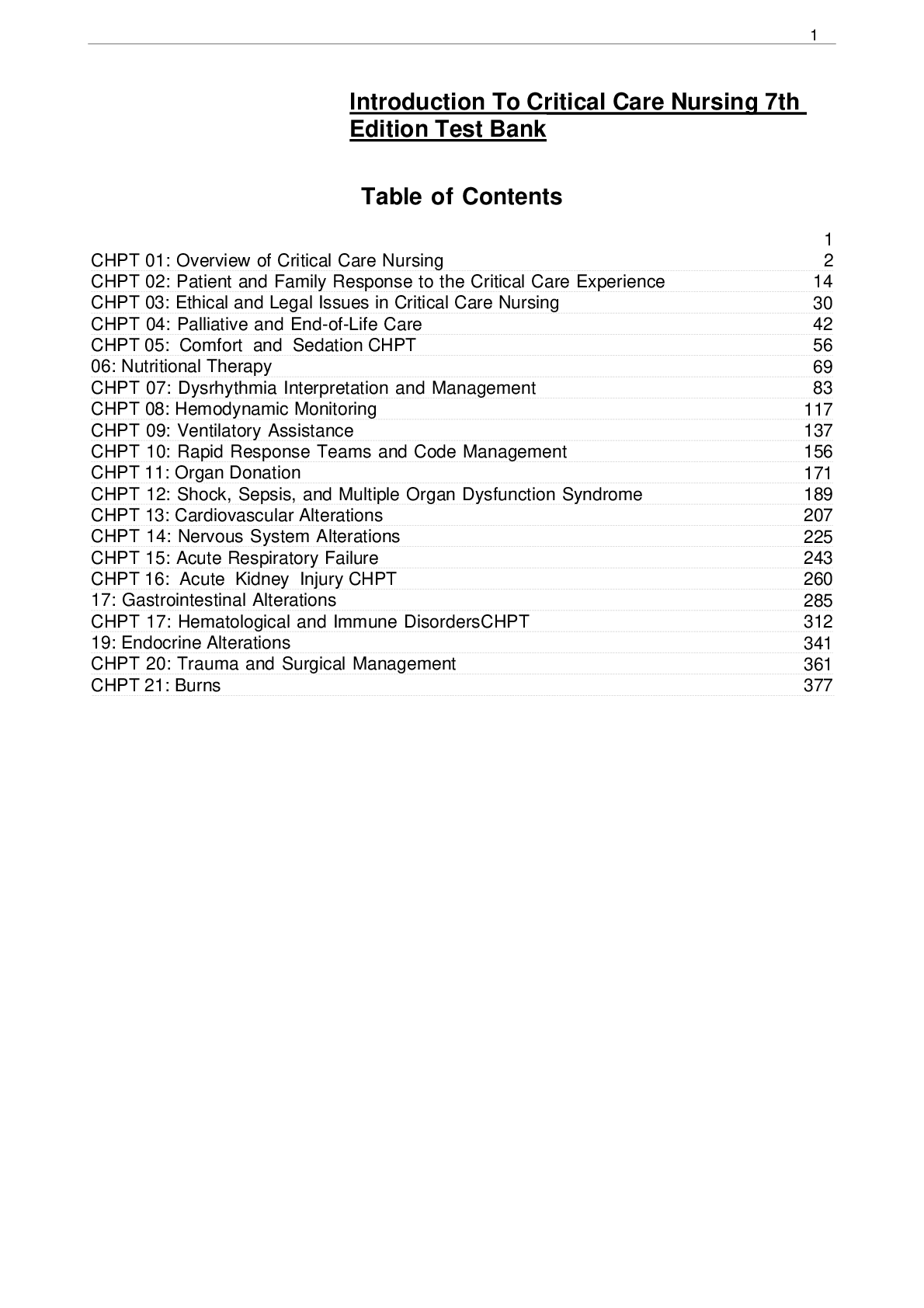*NURSING > TEST BANKS > University of South Africa - ECS 1501-TEST BANKS LATEST BEST RATED.. (All)
University of South Africa - ECS 1501-TEST BANKS LATEST BEST RATED..
Document Content and Description Below
ECS1501 TEST BANK Question 1 As an economic concept, scarcity applies to [1] neither the poor nor the rich. [2] the poor but not the rich. [3] the rich but not the poor. [4] both the poor and th... e rich. THE CORRECT OPTION IS 4 Explanation Scarcity is an economic concept that applies to all individuals rich or poor and to all countries regardless of level of development. Generally resources accessible to individuals and other economic agents are limited and insufficient to meet the agents‟ unlimited desires. No individual has enough resources to do everything that he/she desires and because of that we say resources are scarce. Scarcity must not be confused with poverty; it affects everyone, rich or poor. Question 2 Due to scarcity of resource, [1] the government must decide how to allocate available resources. [2] some members of the society must live in poverty. [3] every society must choose among competing uses of available resources. THE CORRECT OPTION IS 3. [4] every society must undertake central planning. Explanation Due to scarcity of resources, economic agents or society must choose amongst competing uses of available resources. Given that factors of production required to produce all goods and services desired by the society are limited, society has to decide on the best way of allocating these limited resources. It has to choose which goods and services should be produced and which needs or wants should be left unsatisfied. The issue of making choices in the context of scarcity is something that is done by everyone, not only the government. All individuals confronted with the problem of scarce resources should make choices. Question 3 Microeconomics focuses on all of the following EXCEPT the [1] purchasing decisions made by an individual consumer. [2] relationship between inflation and unemployment rates. THE CORRECT OPTION IS 2. [3] employment decision made by a business. [4] decision by a firm to expand its output due to an increase in demand. Explanation In microeconomics the focus is on individual parts of the economy i.e. the behaviour of consumers, firms, etc. Microeconomics studies the price of an individual commodity, the number of people employed in a particular firm or industry, the output produced by firms in a particular sector or industry etc. Microeconomics deals with disaggregated data or individual components of the economy. Inflation and 2 Jameszon31@gmail.com 081 438 7509 / 061 429 0222 / 078 548 0303 unemployment are macroeconomic issues because they relate to the economy as a whole. Thus macroeconomics is the study of broad economic aggregates like inflation, employment, GDP, etc. Question 4 Macroeconomics focuses on all of the following EXCEPT [1] the measurement of a nation‟s inflation rate. [2] how producers and consumers interact in individual markets. THE CORRECT OPTION IS 2. [3] how tax policies influence economic growth. [4] the total output of the economy. Explanation Macroeconomics is concerned with the economy as a whole. It is a study of broad economic aggregates like inflation, economic growth, government tax policies, total output etc. The interaction of producers and consumers in individual markets relates to microeconomics. In this case we are studying individual components of the economy, not the whole economy and that is why we only look at individual markets. Question 5 Which one of the following is a positive economic statement? [1] Government should not redistribute income. [2] Businesses ought to contribute more to charities. [3] Households are the primary source of saving. THE CORRECT OPTION IS 3. [4] The foreign sector should be more tightly controlled. Explanation A positive economic statement is an objective statement of fact that can also be proven by referring to factual information. Positive statements are usually not characterised by phrases like “should”, “ought to” etc. Normative statements are value laden or subjective statements that reflect individual opinion and cannot be verified by referring to facts. Thus the statement that households are the primary source of saving can be proven by looking at the savings pattern in the country. There are statistics gathered by Statistics SA on the savings pattern of businesses, individuals and government in the country. We can use these statistics to see whether a large percentage of national savings is done by households (individuals) or not. Question 6 “Senior citizens deserve an income that will allow them to live in comfort for the remaining years.” This is [1] neither a normative nor a positive statement. [2] both a positive and a normative statement. [3] a positive statement. [4] a normative statement. THE CORRECT OPTION IS 4. Explanation “Senior citizens deserve an income that will allow them to live in comfort for their remaining years” is a normative statement because it reflects an individual‟s opinion 3 Jameszon31@gmail.com 081 438 7509 / 061 429 0222 / 078 548 0303 and it is difficult to prove the validity of this statement. For example, it is difficult to explicitly and objectively define the meaning of the word “comfort”. Being “comfortable” varies from individual to individual and therefore makes this statement normative in nature. Question 7, 8 and 9 are based on the following production possibilities. Table 1 Point Production of grain (tons) Production of LCD televisions (units) A 0 420 B 10 400 C 20 360 D 30 300 E 40 200 F 50 0 Question 7 Which of the following combinations is unattainable? [1] 18 tons of grain and 360 LCD televisions [2] 40 tons of grain and 200 LCD televisions [3] 32 tons of grain and 300 LCD televisions THE CORRECT OPTION IS 3. [4] 10 tons of grain and 390 LCD televisions Explanation A production possibility curve shows all the maximum combinations of two goods that can be produced by efficiently utilising all available resources. Option 1 is attainable It is possible to produce 18 tonnes of grain and 360 LCDs, even though production would be inefficient. If we are producing 360 LCDs, we need to also produce a maximum of 20 tonnes of grain if resources are used efficiently. Option 2 is attainable 40 tonnes of grain and 200 LCDs is an attainable combination, as it lies on the production possibility curve, and is also an efficient point because resources are fully utilised in this case. Option 3 is unattainable The combination of 32 tonnes of maize (grain) and 300 LCDs is not attainable. If we are producing 300 LCDs, we can only produce a maximum of 30 tonnes of grain. Option [4] is attainable If we are producing 10 tonnes of grain, we can also produce a maximum of 400 LCDs. Thus, producing 390 LCDs means we are not fully utilising our resources - this is inefficient production and this point lies inside the production possibility curve. Therefore only option 3 is correct. Question 8 Production is inefficient if this economy produces [1] 18 tons of grain and 360 LCD televisions. THE CORRECT OPTION IS 1. 4 Jameszon31@gmail.com 081 438 7509 / 061 429 0222 / 078 548 0303 [2] 40 tons of grain and 200 LCD televisions. [3] 32 tons of grain and 300 LCD televisions. [4] 10 tons of grain and 400 LCD televisions. Explanation Production is inefficient if this economy produces inside its production possibility curve or boundary. Thus 18 tonnes of grain and 360 LCDs represents a point that lies inside the PPC. If the economy is utilising its resources efficiently, the maximum amount of grain that can be produced when 360 LCDs are produced is 20 tonnes, not 18 tonnes. As explained above, option 3 represents an unattainable, not inefficient, production combination. Question 9 What is the opportunity cost of increasing the production of grain from 20 to 40 tons of grain? [1] 80 LCD televisions [2] 100 LCD televisions [3] 120 LCD televisions [4] 160 LCD televisions THE CORRECT OPTION IS 4. Explanation The opportunity cost of increasing the production of grain from 20 to 40 tonnes is the number of LCDs foregone (sacrificed to free up resources for the additional grain production). Thus 20 tonnes of grain are associated with 360 LCDs and 40 tonnes of grain are also associated with 200 LCDs. Increasing grain production from 20 to 40 tonnes results in the production of LCDs falling from 360 to 200. Therefore the opportunity cost is 360-200 = 160 LCDs. Question 10 Which of the following options is NOT correct? [1] Consumer goods can be classified as non-durable, durable and semi-durable goods. [2] Intermediate goods are goods that are purchased to be used as inputs in producing other goods. [3] Private good is characterised by non-excludability. THE CORRECT OPTION IS 3. [4] The value of capital goods depreciates over time. Explanation A private good is characterised by excludability in consumption, which means that individuals who are not willing to pay to consume the good have no access to the good. Goods that are non-excludable in nature are called public goods. It is impossible to exclude those people who are not willing to pay from the consumption of public goods. Once street lights have been erected, whether an individual has paid for it or not, he/she is still able to „consume‟ the light. This is a case of nonexcludability. Question 11 When a textile company keeps track of its inventory using a computer, while its competitor uses a spread sheet and pencil, they are both answering the ______________ question. 5 Jameszon31@gmail.com 081 438 7509 / 061 429 0222 / 078 548 0303 [1] “what” [2] “how” THE CORRECT OPTION IS 2. [3] “for whom” [4] “where” Explanation Keeping track of inventory using a computer or using a spread sheet and pencil are all input issues related to the method of production. Thus they relate to the “how to produce” aspect of economic questions. Question 12 When firms in an economy start producing more computers and fewer televisions, they are answering the _______ question. [1] “what” THE CORRECT OPTION IS 1. [2] “how” [3] “for whom” [4] “where” Explanation Question 13 When firms in an economy start producing more computers and fewer TVs, they are answering the “what to produce” question. Which of the following statements regarding factors of production is/are correct? a) Profit is income for the entrepreneur, whilst interest is income for capital. b) Land and labour are factors owned by firms, whilst capital and entrepreneurs are owned by households. c) The quantity of labour depends on the size of the population and the proportion of the population that is able and willing to work. [1] Only a and b [2] Only b and c [3] Only c and a THE CORRECT OPTION IS 3. [4] All the statements are correct Explanation Statement (a) is correct. The rewards to factors of production are as follows: interest is paid to capital, rent to land or natural resources, wages to labour and profit to the entrepreneur. Statement (c) is correct The size of the labour force represents the number of people willing and able to work. This number depends on the size and the proportion of the population that is by law able and willing to work, which also depends on the age and gender distribution of the population. Question 14 In the circular flow model of a closed economy with no government sector, households [1] receive income from buyers of goods and services. [2] receive income from the sale of factors of production in the goods market. 6 Jameszon31@gmail.com 081 438 7509 / 061 429 0222 / 078 548 0303 [3] pay firms for the use of their factors of production. [4] receive income from producers for the sale of factors of production in the factor market. THE CORRECT OPTION IS 4. Explanation In the circular flow model of a closed economy with no government sector, households receive income from producers for the sale of factors of production in the factor markets. Remember, all factors of production are owned by households and sold in the factor markets in return for factor income in the form of wages, rent, interest and profits. Question 15 In terms of the circular flow diagram, firms make expenditure in the _____ market and receive income through the _____ market. [1] capital; goods [2] goods; factor [3] goods; financial [4] factor; goods THE CORRECT OPTION IS 4. Explanation In terms of the circular flow of income diagram, firms incur expenditure in the factor market and receive income through the goods market. In the factor market firms will be paying for factor services supplied by households. Firms buy factors of production from households in the factor market and use these factors to produce goods and services, which they sell to households in the goods market. For supplying and selling goods and services in the goods market, firms receive income in the form of sales revenue. Question 16 Which one of the following options correctly lists examples of stock variables? [1] Profit, capital and assets. [2] Assets, liabilities and income. [3] Wealth, unemployment and investment. [4] Wealth, capital stock and money supply. THE CORRECT OPTION IS 4 [Show More]
Last updated: 2 years ago
Preview 1 out of 85 pages
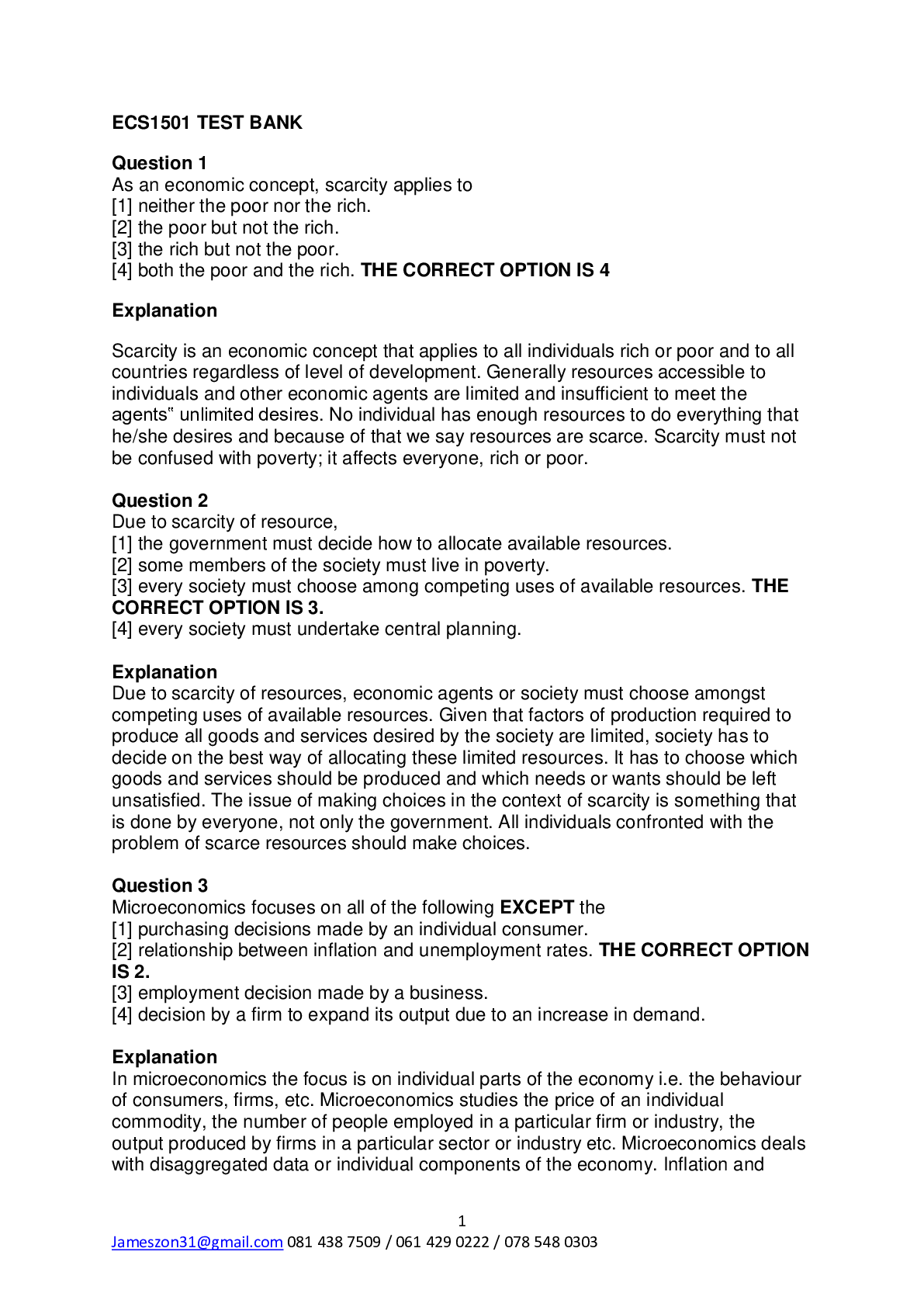
Buy this document to get the full access instantly
Instant Download Access after purchase
Buy NowInstant download
We Accept:

Reviews( 0 )
$15.00
Can't find what you want? Try our AI powered Search
Document information
Connected school, study & course
About the document
Uploaded On
May 03, 2021
Number of pages
85
Written in
Additional information
This document has been written for:
Uploaded
May 03, 2021
Downloads
0
Views
47


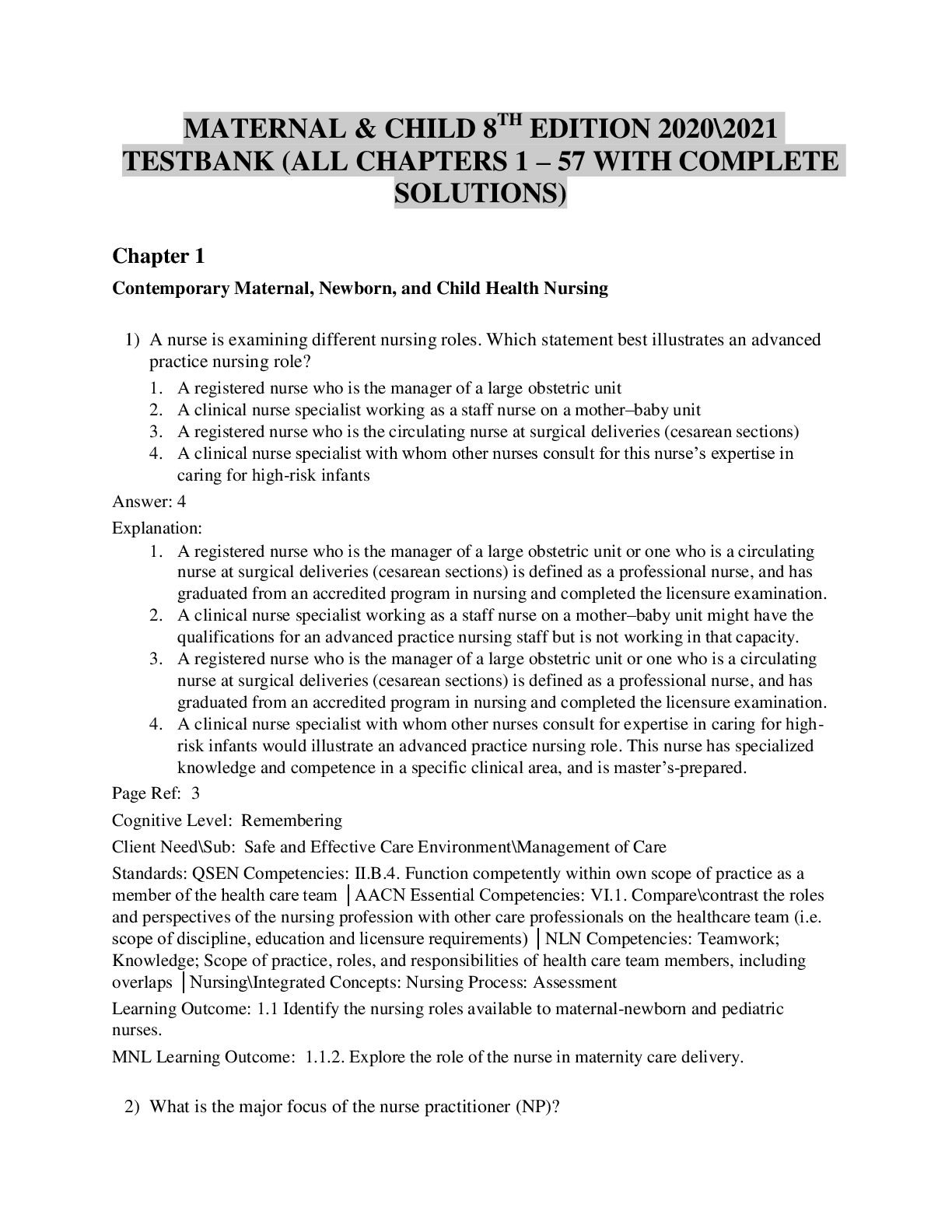

.png)

